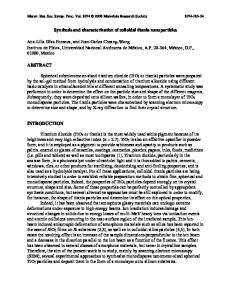Non-template synthesis of titania hollow spheres and their thermal stability
- PDF / 1,963,042 Bytes
- 5 Pages / 612 x 792 pts (letter) Page_size
- 7 Downloads / 254 Views
Uniform and thermally stable spherical titania particles with hollow interiors were directly prepared by a novel solvothermal precipitation of TiCl4 in isopropanol without templates or shape-controller reagents. An average particle size of 700 nm to 1 m was obtained. The hollow spheres consisted of pure anatase phase nanocrystals with an estimated crystallite size of 12–15 nm. Upon heating, the pure anatase phase was retained for temperatures up to 800 °C, which suggested that the spherical structure contributed to phase stability. This method is a promising process for industrial-scale preparation of titania hollow spheres.
I. INTRODUCTION
Oxide hollow spheres are promising materials for applications in catalysis, drug and dye delivery, electronic devices, and biomaterials, and they have attracted increasing attention in recent years.1–3 In general, uniform hollow spheres are obtained by wet-chemical method via a two-step process. First, core-shell structured particles with removable cores are formed. Normally polymer, especially polystyrene and its derivatives,4–8 are used as core material. Emulsions and surfactants stabilized emulsions,9–11 bicontinuous microemulsions,12 and active carbon13 were also used as removable templates. Inorganic materials were coated to the removable core either by controlled reaction or by deposition. Then the core was removed by either solvent etching or calcinations without damage of the shell structure. However, several problems generally exist with these methods. First, the core materials are usually expensive and unstable, and a complicated procedure is required to produce desired core-shell complex. Second, the obtained hollow spheres normally consist of amorphous phase, so calcination is required to obtain stable and crystallized structure. The calcination usually leads to aggregation between spheres and structural degradations such as formation of coarsened shells. Finally, the removal of the core structure by etching or calcination usually leads to a certain degree of damage to the shell structure.14 Therefore, most methods used for inorganic hollow spheres preparation are not suitable for large scale production. Hydrothermal and
a)
Address all correspondence to this author. e-mail: [email protected] DOI: 10.1557/JMR.2005.0130 796
J. Mater. Res., Vol. 20, No. 4, Apr 2005
solvothermal methods have been extensively investigated for the preparation of TiO2 nanoparticles,15–17 but few are used to prepare TiO2 hollow particles. A nontemplate hydrothermal method was used to produce titania microspheres with hollow interiors and an outer diameter of about. 3 m. However, calcination was still needed to create the hollow interior and obtain the crystal phase of the shell.14 Here, we report a novel one-step approach to synthesize crystallized titania hollow microspheres by solvothermal precipitation of TiCl4 in isopropanol solution without use of a template. With control of TiCl4 concentration, reaction time, and temperature, monodispersed hollow titania microspheres w
Data Loading...











